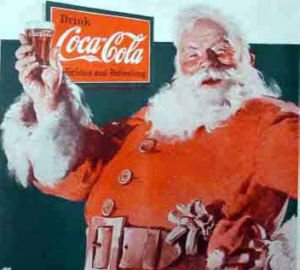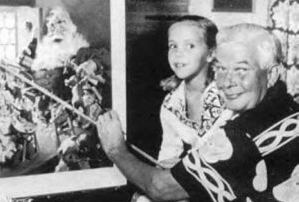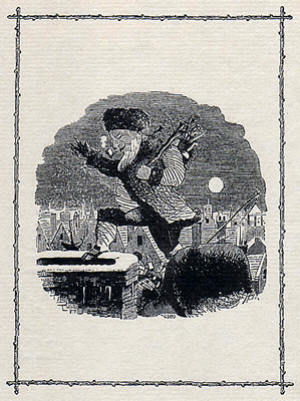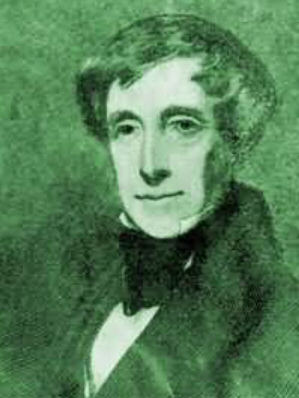Where's Santa Really From? Michigan, Of Course!
|
||||||||||
| Printer Friendly Story View |

First drawing of Santa Claus for the Coca Cola Company was by Michigan native Haddon Sundblom in 1931.

Muskegon, Michigan, native Haddon Sundblom drew his image of Santa Claus for the Coca Cola Company in 1931 that is still used today.
(EDITOR'S NOTE: Ho! Ho! Ho! Merry Christmas from the staff at MyBayCity.com.)
When children, and adults, today think of Santa Claus the image that comes to mind is one drawn by a Michigan artist.
Although the story that started the Santa hysteria was written after a sleigh ride in Greenwich Village, New York, the image that pervades our consciousness is one from a Muskegon, Michigan, artist.
Clement C. Moore's original poem, "A Visit From St. Nicholas," more commonly known as "Twas The Night Before Christmas," flowed from pen to paper in New York City in 1822.
Legend has it that Moore composed the poem for his six children during a snowy Christmas Eve sleigh-ride home from Greenwich Village.
The image of St. Nicholas printed in the Troy, New York, Sentinel on Dec. 23, 1823 was illustrated with an artist's likeness drawing inspiration from Dutch folklore.
"The traditional and somewhat austere St. Nicholas was transformed into a fat and jolly Dutchman," wrote folklore expert Duncan Emrich.
A century was to pass, with various artistic versions of Santa Claus appearing in the media, until Sundblom was commissioned by the Coca Cola Company to draw what he thought the old boy looked like.
Sundblom's masterpiece, depicting Santa as a white-bearded, roly-poly grandfatherly type is still used to sell Coke today.
Michigan History magazine related the background of Sundblom's Santa Claus in 1955:
"Haddon used retired salesman Lou Prentice as his model for Santa Claus as he had the right build and "the wrinkles in his face all seemed to be happy wrinkles which were so evident when he smiled or laughed". When Lou passed away someone suggested Sundblom use himself as a model because by then his broad Nordic face also had the same kind of happy wrinkles.
Below:(Left) The white beard and the gifts emanate from Saint Nicholas's origins as a bishop in Asia Minor in 300 AD. (Right) The elfin character of Santa was described by Clement Moore (pictured) in his poem "Twas the Night before Christmas."


"It was the early Dutch settlers who brought the Sinterklaas or St Nicholas concept to America. The white beard and the gifts emanate from Saint Nicholas's origins as a bishop in Asia Minor in 300 AD. The chimney and the short pipe are Dutch. Add to that the elfin character of Santa as described by Clement Moore in his poem "Twas the Night before Christmas" and you get the version of Santa Claus that illustrator Thomas Nast made popular in 1850. Walt Disney made Santa more human in his 1932 workshop film but it was Haddon Sundblom who finally transferred Santa into a real flesh-and-blood person."
Sundblom, youngest of nine children was born in Muskegon in 1899 to Swedish immigrants. His father had been a shipbuilder in Finland and passed to his son the traits of attention to detail and perseverance.
Sundblom's mother died when he was 13 and in the sixth grade. A year later he quit school and worked in Chicago for contractors and took night classes in art and architecture. While attending the Art Institute of Chicago and the American Academy of Art, he built a portfolio that earned him an apprenticeship with a commercial art studio.
He later opened his own studio and trained many illustrators who became known as the "Sundblom Circle." He painted ads for Packard, Ford, Lincoln, Pierce-Arrow and Marmion automobiles. Besides various versions of the Coca Cola Santa from 1931 to 1964, when Coke shifted its advertising focus, he created such advertising icons as the Quaker Oats man and Sprite Boy.
Sundblom also painted many pin-up girls and did a cover for Playboy's 1972 Christmas issue. While working on a portrait of Christ, he fell ill and died March 10, 1976.
In a 1974 interview with a Rolling Stone reporter, he was asked how he liked Coke. "I never could stand the stuff," remarked the man who through his art probably sold more of it than any other person.
| Printer Friendly Story View |
|
|

Dave Rogers |
|
|
|
Printer-Friendly Story View
0200 Nd: 04-15-2024 d 4 cpr 0
12/31/2020 P3v3-0200-Ad.cfm
SPONSORED LINKS
12/31/2020 drop ads P3v3-0200-Ad.cfm


